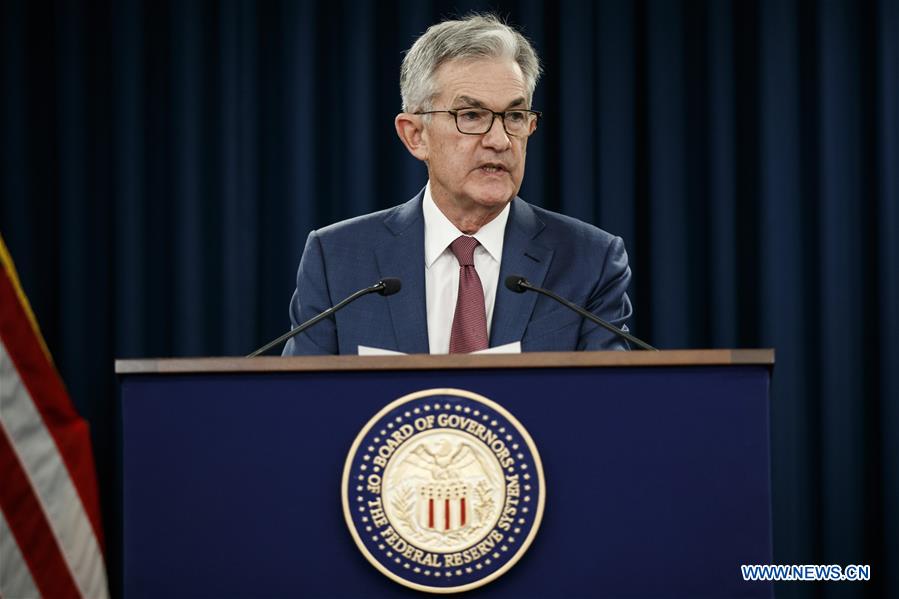
U.S. Federal Reserve Chairman Jerome Powell speaks during a press conference in Washington D.C., the United States, on Oct. 30, 2019. U.S. Federal Reserve on Wednesday lowered interest rates by 25 basis points amid a further slowdown in U.S. economic growth, the central bank's third rate cut this year. (Photo by Ting Shen/Xinhua)
by Xiong Maoling, Gao Pan
WASHINGTON, Oct. 30 (Xinhua) -- U.S. Federal Reserve on Wednesday lowered interest rates for the third time this year amid a further slowdown in U.S. economic growth, but signaled a pause in easing cycle.
The Federal Open Market Committee (FOMC), the Fed's rate-setting body, trimmed the target for the federal funds rate by 25 basis points to a range of 1.5 percent to 1.75 percent after concluding its two-day policy meeting, largely in line with market expectation.
"We took this step to help keep the U.S. economy strong in the face of global developments and to provide some insurance against ongoing risks," Fed Chairman Jerome Powell told reporters at a press conference Wednesday afternoon, highlighting the risks of slowing global growth, trade policy developments, as well as muted inflation pressure.
U.S. ECONOMIC SLOWDOWN
Despite strong household spending, business investment and exports "remain weak," and manufacturing output has declined over the past year, Powell said. "Sluggish growth abroad and trade developments have been weighing on those sectors," he said.
The U.S. economy expanded at an annual rate of 1.9 percent in the third quarter of the year, slightly lower than the 2-percent growth rate in the second quarter, the Commerce Department reported earlier on Wednesday. This marks a further deceleration from the first quarter's 3.1-percent growth rate.
Personal consumption expenditures (PCE), which account for more than two-thirds of the overall economy, grew at an annual rate of 2.9 percent in the third quarter, lower than the 4.6-percent growth pace in the second quarter. Nonresidential fixed investment, meanwhile, fell at an annual rate of 3 percent in the third quarter, following a contraction of 1 percent in the previous quarter.
In the 12 months through August, overall inflation and inflation for items other than food and energy were running below the central bank's 2-percent objective, Powell said, noting that total PCE inflation was 1.4 percent and core inflation was 1.8 percent.
Powell said a potential trade agreement between the United States and China, if signed and put into effect, would "bode well" for business confidence and perhaps activity over time. "That has the potential for being an improvement in the risk picture," he said.
The Fed lowered interest rates in late July for the first time since the 2008 global financial crisis. Calling it a "mid-cycle adjustment" to the central bank's monetary policy, Powell said back then the rate cut was "not the beginning of a long series of rate cuts."
It then trimmed rates in September after its policy meeting, amid growing risks and uncertainties stemming from trade tensions and a global economic slowdown.
POSSIBLE PAUSE IN POLICY EASING
In a statement released Wednesday, the FOMC said it will continue to monitor the implications of incoming information for the economic outlook as it assesses the appropriate path of the target range for the federal funds rate. It left out the phrase that the Fed "will act as appropriate to sustain the expansion," which was considered the signal for rate cut in previous statements.
It suggested the Fed "has reached a pausing stage" in its policy easing, in the absence of a "material reassessment" of the outlook, Krista Schwarz, an assistant professor of finance at the Wharton School of the University of Pennsylvania, told Xinhua via email.
"This is against the backdrop of abating uncertainty in global risks to U.S. growth, with phase one of a China trade deal materializing and a reduced likelihood of a no-deal Brexit," Schwarz said, adding that the effects of policy easing from rate cuts earlier this year have shown up in such areas as consumer sentiment and the housing market.
"Since the current stance of policy implies a real rate of interest that is below most estimates of the neutral real rate, monetary conditions are accommodative, and it is possible that the next rate change may be a tightening," Schwarz said.
In light of continuing solid economic data, it is "reasonable" for the Fed to pause for now, said Joseph Gagnon, senior fellow at the Peterson Institute for International Economics, adding that stock prices and bond yields did not move much after the Fed's announcement.
Looking ahead, Tim Duy, professor at the University of Oregon and a long-time Fed watcher, wrote in a blog post that the market should expect an extended policy pause. "The Fed is neither interested in easing policy further given their outlook nor in soon raising rates back up given continued below-target inflation," Duy said.











